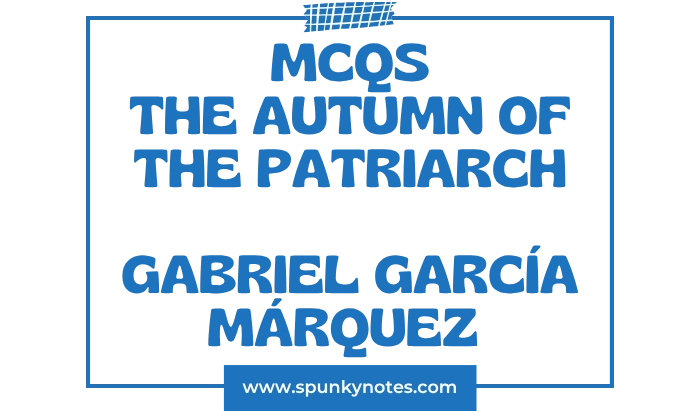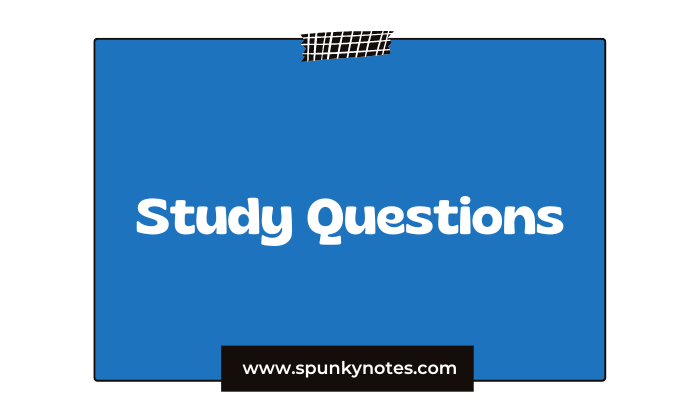
The Autumn of the Patriarch MCQs
1. What first entered the presidential palace, stirring stagnant time?
A. Peasant troops
B. Flapping wings
C. Rotting grandeur
D. Armored doors
2. What covered the palace courtyards due to abandonment?
A. Reinforced stone
B. Underground weeds
C. Lunar dust
D. Fallen portraits
3. What former viceregal area had been transformed into a coach house?
A. Stable
B. Kitchen
C. Garden
D. Courtyard
4. What animals wandered through the ruined palace, eating curtains?
A. Street dogs
B. Bold vultures
C. Brazen cows
D. Jaguars
5. What kind of machinery was abandoned in a palace corner?
A. Wind machine
B. Sewing machines
C. Printing press
D. Musical box
6. What was displayed on all coins, stamps, and condom labels?
A. The flag
B. His profile
C. Vultures’ image
D. A dragon
7. Where did the Patriarch keep the good ammunition for the armed forces?
A. Conde barracks
B. Harbor fort
C. Arsenal in the palace
D. San Jerónimo base
8. What unique physical feature was observed on the Patriarch’s feet?
A. Small and stubby
B. Like hawk talons
C. Soft and smooth
D. Bandaged
9. How many years did the Patriarch estimate he had lived when the comet passed?
A. Fifty years
B. A hundred
C. Two hundred
D. Three hundred
10. How long did the bells of the cathedral toll following Bendición Alvarado’s death?
A. Three days
B. One week
C. One hundred days
D. A century
11. Who was the Patriarch’s perfect double used for public duties?
A. Rodrigo de Aguilar
B. Patricio Aragonés
C. Saturno Santos
D. José Ignacio Saenz
12. What was Patricio Aragonés’s original trade before becoming the double?
A. Glass-blower
B. Soldier
C. Vendor of miracles
D. Artilleryman
13. What was Patricio Aragonés’s nominal monthly salary?
A. Three hundred pesos
B. Fifty pesos
C. Four hundred pesos
D. Ten cents
14. How was Patricio Aragonés eventually assassinated?
A. Machine-gun burst
B. Dynamite charge
C. Poisoned dart
D. Domino game
15. What humiliation did Patricio Aragonés suffer during his agony?
A. Being strangled
B. Dying of fear
C. Soaked in shit
D. Stabbed by General
16. Who was the Patriarch’s lifelong comrade and Minister of Defense?
A. Patricio Aragonés
B. José Ignacio Saenz
C. Rodrigo de Aguilar
D. Bonivento Barboza
17. What horrifying fate befell General Rodrigo de Aguilar?
A. Dynamite explosion
B. Quartered by horses
C. Assassinated privately
D. Served roasted at the banquet
18. Who was brought in to establish a secret empire of repression?
A. Ambassador Wilson
B. José Ignacio Saenz
C. General Barboza
D. Rubén Darío
19. What material was used to stuff Bendición Alvarado’s body after its miracle failed?
A. Cotton wool
B. Sawdust and rags
C. Earth and stones
D. Linen
20. What was typically contained in the fiber sacks sent by Saenz de la Barra?
A. Coconut fiber
B. Gold coins
C. Severed heads
D. Stolen goods
21. How did the Patriarch always sleep, face down or face up?
A. With a pillow
B. Face down
C. On his side
D. Fully clothed
22. What item did the Patriarch wear on his left heel?
A. Iron boot
B. Gold spur
C. Velvet glove
D. Canvas truss
23. What large medical device was worn due to a physical anomaly?
A. Orthopedic cart
B. Gold spur
C. Canvas truss
D. Small eyeglasses
24. What time of day was considered the mortal hour of siesta?
A. Dawn
B. Noon
C. Mortal hour
D. Late afternoon
25. What did the Patriarch keep trying to kill in his ears to help him think?
A. Mosquitoes
B. Buzzing
C. Katydids
D. Vultures
26. What substance was found to be the supposed remedy for lepers?
A. Salt of health
B. Cocoa butter
C. Creolin
D. Turpentine
27. What animal characteristic was attributed to the Patriarch’s immense appetite for power?
A. Elephant
B. Lizard
C. Manatee
D. Bison
28. What activity did the Patriarch continue to do daily since taking possession of the house?
A. Milking cows
B. Writing decrees
C. Playing dominoes
D. Lighting lanterns
29. What type of physical injury was the Patriarch supposedly only vulnerable to?
A. Stab wounds
B. Coup de grace
C. Gunshot to the back
D. Dynamite
30. What phrase did the Patriarch use to dismiss his ministers’ urgent reports?
A. Long live the stud
B. God damn it
C. Never in a million
D. Don’t tell me the truth
31. What title did the Patriarch proclaim for his mother by decree?
A. Saint of Birds
B. Matriarch of the land
C. First Lady
D. Queen Mother
32. What occupation did Bendición Alvarado follow involving animals?
A. Milker
B. Bird-woman
C. Turkey breeder
D. Hen owner
33. Where was Bendición Alvarado exiled after diplomatic embarrassment?
A. Convent
B. Suburban mansion
C. Harbor fort
D. Dogfight district
34. What did Bendición Alvarado frequently worry about regarding her son?
A. His health
B. His poverty
C. His enemies
D. His loneliness
35. Where was Leticia Nazareno kidnapped from and initially held?
A. Dominican Republic
B. Jamaica
C. Cuba
D. Curaçao
36. What was Leticia Nazareno’s previous occupation before captivity?
A. Concubine
B. Socialite
C. Novice nun
D. First lady
37. What name was given to Leticia Nazareno’s seven-month-old child?
A. Patricio
B. Emanuel
C. Rodrigo
D. Zacarías
38. What evil virtue did Leticia Nazareno’s touch possess?
A. Curing lepers
B. Cursing enemies
C. Causing mold
D. Speaking truth
39. What animals tore Leticia Nazareno and Emanuel to pieces?
A. Hungry cows
B. Stray dogs
C. Vultures
D. Jaguars
40. What was the Patriarch’s immediate reaction to the news of Leticia Nazareno’s death?
A. Wept with rage
B. Sent assassins
C. Ordered war
D. Fled the palace
41. What title did Manuela Sanchez hold at the time of the Patriarch’s fascination?
A. Carnival Queen
B. First Lady
C. Queen of the Póor
D. Divine Messenger
42. What physical detail of Manuela Sanchez did the Patriarch obsess over?
A. Her pale lips
B. Her licorice smell
C. Her soft hands
D. Her green eyes
43. What major natural event occurred during Manuela Sanchez’s disappearance?
A. Earthquake
B. Total eclipse
C. Hurricane
D. Comet passage
44. What was the ultimate consequence of trying to win the lottery fairly?
A. Massive payout
B. Children kidnapped
C. Bankrupted government
D. Public exposure
45. How did the Patriarch resolve the problem of the kidnapped children?
A. Released them
B. Blew them up at sea
C. Sent them to the jungle
D. Adopted them all
46. What event led to the U.S. being granted the rights to exploit the nation’s subsoil?
A. Yellow fever epidemic
B. Sale of the sea
C. Hamburg bankers’ blockade
D. Assassination plot
47. What natural resource did foreign powers eventually carry off entirely from the nation?
A. Cocoa
B. Quinine
C. The sea
D. Gold mines
48. What did the Patriarch use to defend himself from Ambassador Wilson’s importuning about the debt?
A. The Bible
B. A handgun
C. Listening to birds
D. The velvet glove
49. What did the crowds believe was the real reason the Patriarch survived everything?
A. His courage
B. His prudence
C. His destiny knowledge
D. His love
50. What did the crowds celebrate at the novel’s end, signaling liberation?
A. New President
B. Peace Treaty
C. His death
D. Return of the sea
Brief Overview
The Autumn of the Patriarch is a novel by Gabriel García Márquez, published in 1975. The book employs Magic Realism to portray the absolute power, extreme loneliness, and profound corruption of an ancient, unnamed dictator, referred to only as the Patriarch.
The novel opens with the death of this mighty ruler in his presidential palace. Vultures enter the palace through broken windows. The smell of his rotting body awakens the city.
When people finally enter, they find the palace in a massive state of disarray. Cows wander inside, eating curtains and carpets. The dead man is lying on the floor in a simple uniform, his face unrecognizable because no one has ever truly seen him.
The story illustrates how the dictator maintained power for an impossibly long period, blurring the passage of time itself. He ruled through intense fear, trickery, and profound loneliness.
The narrative mentions Patricio Aragonés, a perfect double whom the dictator used for public appearances. It also details the regime’s corruption, including acts of torture and the symbolic selling of the sea to a foreign power.
The novel concludes with the suggestion that the dictator is finally dead, and his long, oppressive rule has truly come to an end.

